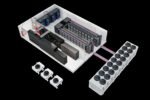 At the International Supercomputing Conference (ISC), Kirk Skaugen, Intel Corporation vice president and general manager of the Data Centre Group, outlined the company’s vision to achieve ExaFLOP/sperformance by the end of this decade. An ExaFLOP/s is quintillion computer operations persecond, hundreds times more than today’s fastest supercomputers.
At the International Supercomputing Conference (ISC), Kirk Skaugen, Intel Corporation vice president and general manager of the Data Centre Group, outlined the company’s vision to achieve ExaFLOP/sperformance by the end of this decade. An ExaFLOP/s is quintillion computer operations persecond, hundreds times more than today’s fastest supercomputers.
Reaching exascale levels of performance in the future will not only require the combinedefforts of industry and governments, but also approaches being pioneered by the Intel Many Integrated Core (Intel MIC) architecture, according to Skaugen.
Managing the explosive growth in the amount of data shared across the Internet, finding solutions to climate change, managing the growing costs of accessing resources such as oil and gas, and a multitude of other challenges require increased amounts of computing resources that only increasingly high-performing supercomputers can address.
While Intel Xeon processors are the clear architecture of choice for the current TOP500 list of supercomputers, Intel is further expanding its focus on high-performance computing by enabling the industry for the next frontier with our many integrated Core architecture for Peta scale and future Exascale workloads,” says Skaugen. “Intel is uniquely equipped with unparalleled manufacturing technologies, new architecture innovations and a familiar software programming environment that will bring us closer to this exciting exascale goal.”
To address this challenge, Intel and European researchers have established three European labs with three main goals: to create a sustained partner presence in Europe; take advantage of the growing relevance of European high-performance computing (HPC) research and exponentially grow capabilities in computational science, engineering and strategic computing.
One of the technical goals of these labs is to create simulation applications that begin to address the energy efficiency challenges of moving to Exascale performance.
Skaugen says there is the potential for tremendous growth of the HPC market. While supercomputers from the 1980s delivered GigaFLOP/s (billions of floating point operations per second) performance, today’s most powerful machines have increased this value by several million times. This, in turn, has increased the demand for processors used in super computing.
By 2013 Intel expects the top 100 supercomputers in the world to use one million processors. By2015 this number is expected to double, and is forecasted to reach 8 million units by the end of the decade.










